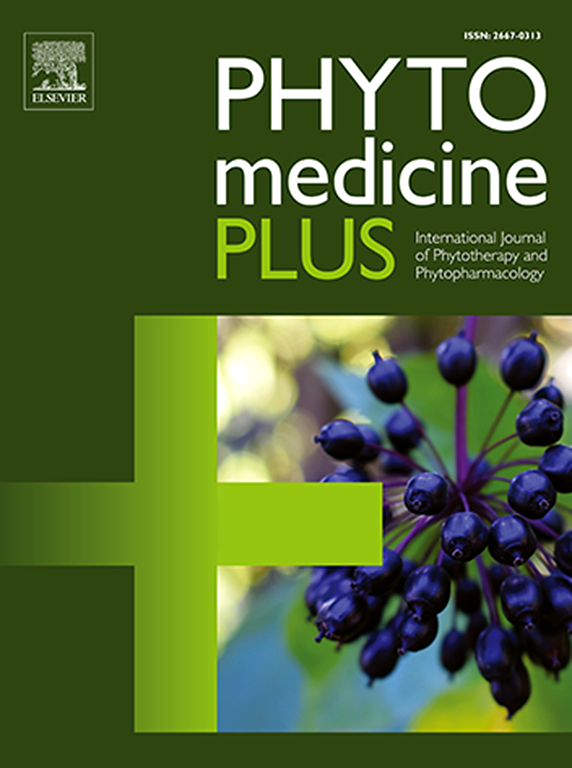乌干达姆巴拉拉市用于治疗子宫肌瘤的药用植物的民族植物学、区系学和植物化学研究
Q3 Pharmacology, Toxicology and Pharmaceutics
引用次数: 0
摘要
子宫肌瘤是绝经前女性最常见的非癌性良性妇科肿瘤。在乌干达,UF的患病率估计为20%,已经确定了导致这一患病率的几个风险因素。本研究旨在记录乌干达西南部姆巴拉拉市传统医学从业者在UF管理中使用药用植物的民族植物学知识。TMPs在该地区的医疗保健中发挥着至关重要的作用,通常在提供草药治疗之前结合超声扫描等传统诊断方法。为了达到研究目的,数据收集于2024年4月至2024年5月,采用结构化问卷进行管理。使用有目的和滚雪球抽样技术选择了二十六(26)名受访者。收集了社会人口学特征、寻求治疗行为和使用中草药方剂治疗UF的数据。统计分析包括描述性统计、被引频次、相对被引频次和保真度的计算。我们的结果表明,大多数TMPs在开始草药治疗之前了解UF并重视常规诊断手段。共鉴定植物47种,隶属于32科45属。最常见的科为豆科(10.6%)、Asteraceae(8.5%)、Lamiaceae(8.5%)、Asparagaceae(6.4%)和葫芦科(6.4%)。同时,被引频次最高的植物有sinuatum、Hoslundia opposita、Opuntia ficus-indica、Sesamum angustifolium、Phyllathus niruri、Ricinus communis、Erythrina abyssinica和Leonotis nepetifolia。草本植物(61.7%)、乔木(23.4%)和灌木(14.9%)的叶(47.6%)、茎(17.5%)和花(9.5%)是制备口服煎剂的主要植物部位(94%)。经典的植物化学筛选从8个最常被引用的物种的植物器官显示黄酮类、植物甾醇、萜类、皂苷和生物碱。随着次生代谢产物生物活性的初步证据,本研究强调需要进一步的生物测定指导研究,以分离和表征与该物种抗肌瘤功效相关的生物活性分子。本文章由计算机程序翻译,如有差异,请以英文原文为准。
Ethnobotany, floristic and phytochemical studies of medicinal plants used to treat uterine fibroids in Mbarara City, Uganda
Uterine fibroids (UF) are the most common non-cancerous benign gynaecologic tumours in premenopausal females. In Uganda, the prevalence of UF is estimated at 20%, and several risk factors have been identified as contributing to this prevalence. This study aimed to document the ethnobotanical knowledge of traditional medicine practitioners (TMPs) in Mbarara City, Southwestern Uganda on the use of medicinal plants for UF management. The TMPs play a vital role in the healthcare within this region, often incorporating conventional diagnostic methods such as ultrasound scans before providing herbal treatments. To achieve the study aim, data was collected from April 2024 to May 2024 using structured questionnaires administered. Twenty-six (26) respondents were selected using purposive and snowball sampling techniques. Data were gathered on sociodemographic characteristics, treatment-seeking behaviour, and use of herbal formularies for treatment of UF. Statistical analysis involved descriptive statistics, and computation of the frequency of citation, relative frequency of citation and fidelity level. Our results indicated that most TMPs knew about UF and valued conventional means of diagnosis before initiating herbal treatment. Forty-seven (47) plant species belonging to 32 families and 45 genera were identified. Fabaceae (10.6%), Asteraceae, Lamiaceae (8.5% each), Asparagaceae and Cucurbitaceae (6.4% each) were the most ordinary families. At the same time, Oxygonum sinuatum, Hoslundia opposita, Opuntia ficus-indica, Sesamum angustifolium, Phyllathus niruri, Ricinus communis, Erythrina abyssinica and Leonotis nepetifolia were the most frequently cited species. Leaves (47.6%), stems (17.5%) and flowers (9.5%) of herbs (61.7%), trees (23.4%) and shrubs (14.9%) were the primarily utilized plant parts for preparing decoctions that are administered orally (94%). Classical phytochemical screening of plant organs from the eight most cited species indicated flavonoids, phytosterols, terpenoids, saponins and alkaloids. With initial evidence of the bioactive secondary metabolites, this study underscores the need for further bioassay-guided studies to isolate and characterize bioactive molecules associated with the anti-fibroid efficacy of the species.
求助全文
通过发布文献求助,成功后即可免费获取论文全文。
去求助
来源期刊

Phytomedicine Plus
Medicine-Complementary and Alternative Medicine
CiteScore
3.70
自引率
0.00%
发文量
178
审稿时长
81 days
期刊介绍:
 求助内容:
求助内容: 应助结果提醒方式:
应助结果提醒方式:


